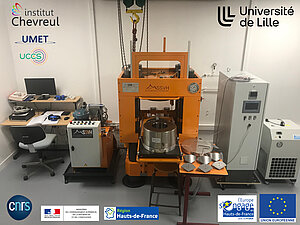The High Pressure Laboratory is located in the building of the Institut Chevreul, on the Cité Scientifique campus of the Université de Lille (access map). The laboratory holds a range of instruments for the synthesis and the caracterisation of centimeter-size materials up to 2 GPa and 2200°C, millimeter size samples up to 20 GPa and 2200°C, and sub-millimeter-size at pressures over 200 GPa.
What is a GPa? The GPa is a unit commonly used for high pressures. 1 GPa is 109 Pa or 10 000 bars (10 kbars). The equipment we have hence allow pressures of 200 kbars for millimeter-size samples and 2 Mbars (megabars) for sub-millimeter samples.
Why? Those pressures are found in the interior of the Earth and planets. On Earth, for instance, pressure is 24 GPa at 660 km depth, at the boundary between the upper and lower mantle, 135 GPa at the core-mantle boundary, and 365 GPa at the center of the planet. The application of pressure brings the atoms together, can change their electronic structure, and can fundamentaly change their physical properties. High pressure experiments allow to synthetize materials never made under regular conditions of pressure and temperature.
The lab
The High Pressure Lab is run by researchers, technicians, and engineers at the Unité Matériaux et Transformations and the Unite de catalyse et Chimie du solide, partner laboratories within the Institut Chevreul.
The lab includes a range of instruments for the synthesis and characterization of centimeter size samples up to 2 GPa and 2200°C, millimeter size samples up to 20 GPa and 2200°C, and sub-millimeter at pressures above 200 GPa, as well as supplies and equipments for preparing those experiments.
Instruments and laboratory spaces
Our instruments:
- a piston-cylinder press for pressures up to 2.2 GPa and temperatures of 2200°C,
- a multi-anvil press to reach pressures on the order of 20 GPa and temperatures of 2200°C,
- diamond anvil cells for pressures above 200 GPa.
Laboratory spaces:
Research at the high pressure lab
-
the Earth and Planetary Materials team at UMET works on materials under deep Earth conditions. Processes in the interior of planets are difficult to constrain because we can only rely on a few direct observations. In their work, team members aim at understanding how the behavior and microscopic properties of rocks can affect the dynamics of the deep Earth and observations of the Earth as we observe it today.
-
the Inorganic materials, structures, systems and properties team of the UCCS develops innovative inorganic compounds, new material with magnetic, electronic and even optic properties for various applications (spintronic, luminescent materials, oxidation catalysis, photocatalysis for hydrogen production, …).
-
the Matériaux Moléculaires et Thérapeutiques team at'UMET works on the physical state of molecular materials composed of small molecules and/or of biological molecules under various stresses: temperature, pressure, grinding, dehydration. The main goal is to analyse the situations of metastabilities, the glassy states and the phase transformations and out-of-equilibrium evolutions induced by these stresses. The investigated materials are also found in the pharmaceuticals and food domains. These works have direct implication in the control of the formulation and the stability of these materials with direct consequences on their bioavailability.












